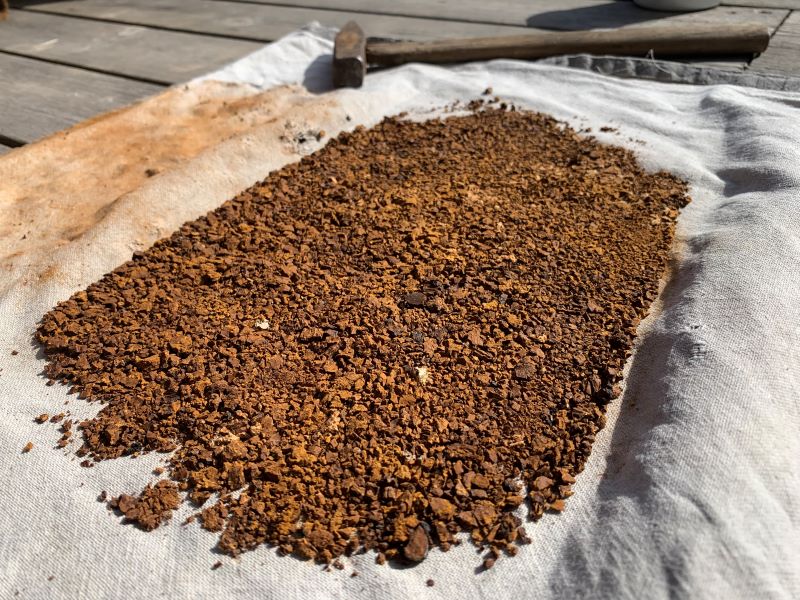This blog post is about how to make Chaga tea.
This post contains affiliate links.
Chaga is the king of medicinal mushrooms. While it recently became popular in the west, Chaga has been consumed for centuries in different cultures. Some of them drank it as an alternative to coffee and others for its powerful healing benefits.
By brewing Chaga in hot water you extract many of it’s beneficial nutrients and drink it in a warm cup of tea. Although Chaga tea is very dark, the taste is actually quite mild. It tastes like forest, rich and earthy, with hints of vanilla.
If you want to know more about Chaga mushroom, how to sustainably harvest it and how to make Chaga tea, then keep on reading!
What is Chaga?
Chaga mushroom (Inonotus obliquus) is a fungus that grows on the bark on birch trees in the northern hemisphere. It is actually a parasite on the tree, as it takes the tree’s nutrients and gives nothing in return. Still, the birch tree can live decades with the Chaga mushroom growing on them. Chaga grows on the bark of the birch and forms a rough black conk. While the black outside is hard, the inside is orange-colored and feels like cork when you touch it. It can be found on 1 of 5000 birch trees, which means it can be quite difficult to find.
Chaga is also called the king of medicinal mushrooms. This because the consuming of it offers some impressive health benefits!
History of Chaga and Chaga Tea
Although Chaga recently has become popular as a super food, it has been used for its healing properties for centuries. It was first used as natural medicine by indigenous people from Siberia, Russia and North America. It has also been used by Asian countries and been part of Chinese medicine for hundreds of years. Chaga was used to cure different ailments and was even used to cure mouth cancer in the 12th century.
The earliest sign of humans using Chaga is from Ötzi the Iceman. He was found by some hikers in 1991 and estimated to have been preserved in a glacier for over 5300 years! Along with some tools, they found remnants from Chaga in his pouch. Historians didn’t know for sure what it was used for, but they suspected it was for starting a fire. Anyway it’s super interesting that Chaga was already used by humans so many thousand years ago.
The Health Benefits of Chaga
Chaga is full of powerful ingredients and stuffed with antioxidants. Therefore Chaga has some impressive health benefits! Also, you can’t overdose Chaga and it’s save to use over a longer time. You should however be careful if you’re pregnant, are using blood thinners, have kidney problems or diabetes. If so, discuss drinking Chaga tea with a trusted health care provider first.
Here are some of the scientifically proven health benefits of Chaga!
1. Strengthens the immune system
A healthy immune system is an important part of our overall health. With a strong immune system, our bodies can fight of colds and illnesses from harmful pathogens like bacteria, viruses and parasites. Chaga contains a compound called Beta-d-glucan, which strengthens the immune system. Beta-d-glucan is a polysaccharide that helps to balance the immune system by either boosting it when there’s an ongoing threat, or turn down an overactive immune system.
This means that drinking Chaga tea regularly can strengthen the immune system which in turn can prevent you from getting sick.
✧ Read: How to make Super Healthy Ginger Shots
2. May prevent cancer
Several studies have shown that Chaga can prevent cancer and fight against tumor growth.
The Beta-d-glucan in Chaga increases natural killer cells, which are important cells that help to fight infected cells and early tumor cells.
It is also thought that the high antioxidant levels in Chaga are a reason that it may prevent cancer. Antioxidants reduces cell damage created by free radicals. With less cell damage, the risk of mutagenic cells are lowered.
It’s however important to know that these studies were done on animals and in test tubes, and that human studies needs to be done before making strong conclusions.
3. Reduces inflammation.
Inflammation is caused when the body is fighting of harmful invaders in the body. It is therefore a good response of the immune system and gets your body to actively work towards kicking invaders out so it can heal. Long term inflammation however, is not good. When inflammation becomes chronic it can cause pain, damage to our body and lead to different illnesses.
Chaga contains many compounds that inhibit the production inflammatory cytokines. It can therefore help with chronic inflammation and lower inflammation in the body.
✧ Read: How to make Kombucha
4. High in antioxidants
Chaga is very high in antioxidants, which fights oxidative stress in the body. Oxidative stress causes damage and fast aging to our cells and antioxidants fights it, so that doesn’t happen.
The capacity of antioxidants is measured in Oxygen Radical Absorbance Capacity (ORAC). With an ORAC of 146,700, Chaga scores high on the list of foods with the highest antioxidant levels!
Especially the outer black part are high in polyphenols, which are antioxidants. The antioxidants in Chaga may support liver health, lower high blood pressure and protect against other illnesses that are caused by oxidative stress.
5. Acts as an adaptogen
Chaga acts as an adaptogen. Adaptogens help the body to adapt to inner and outer stress, and makes you more resilient to it. This means that you can handle challenges better and not get as exhausted by them. Adaptogens also have the power to bring back the body to a healthy balanced state. Therefore, regularly drinking Chaga tea can make you feel calm, balanced and more stress resilient.
How to Make Chaga tea
How to Identify Chaga
It is of course important to know how to identify Chaga. Because there can be other things that grow on birch trees, like burls for example. A good thing to remember is that Chaga grows like a chunk on the outside of the birch tree and not on the inside. Chaga therefore isn’t covered in bark, like burls can be. Instead it grows from the bark of the tree and has a rough black surface. If you are not sure if you have found Chaga, carefully check under the black surface. The inside should be rusty orange-colored.
How to Sustainably Harvest Chaga
When you go out in the forest to harvest Chaga, there are some important things to think about! Firstly, be sure that you have permission of the forest owner to take the Chaga from the trees. Secondly, make sure that you leave at least 20% of the Chaga mushroom on the tree so it can grow back. This will also ensure that you won’t accidentally harm the tree by cutting in its bark. Thirdly, it is important that you only harvest from living trees, as Chaga needs a living tree to survive.
Another thing that’s important is the timing of the harvest. It is best to harvest Chaga in late autumn and winter. This because in spring and summer the birch tree contains much more water, and so does the mushroom. Ideally you want to harvest them when it’s several degrees below Celsius outside to ensure you harvest a nutrient rich piece of Chaga. Another tip is that bigger Chaga growths contain more nutrients than smaller ones. This because it has lived longer and had more time to collect nutrients from the tree. Therefor it is smart to harvest from big Chaga chunks and let the smaller ones grow for a while longer.
Also, do not harvest Chaga near a road or other polluted area. Because mushrooms are natural bio-accumulators and absorb toxins and heavy metals from their environment. We do not want that in our tea!
Prepare the Harvested Chaga
When you have harvested the Chaga, it is important that you immediately take care of it afterwards to avoid it from molding. You can make tea, a tincture or dry it for later use. If you are going to use it in a tea immediately after picking it, you do not have to go through the drying process. A good tip is to not harvest too much, because the fresher it is the more potent. Only take what you need. You can harvest more the next time!
Start with cleaning the Chaga. You can do that by scraping of anything that isn’t Chaga with a knife and scrub it with a brush. Do NOT remove the outer black layer of the Chaga, as it contains many of the health beneficial compound. Really get into all the creaks and crevices to remove any dirt and loose debris. When the Chaga is clean you have to break it into smaller pieces. You can do this by wrapping the Chaga in a cloth, placing it on a sturdy surface and hammer on it.
Now when you have the small pieces we are going to dry them. Let them air dry on warm and dry place for a few days. All the moisture should be gone and the chunks are going to be hard as stone. If you want the process to go faster, then let them dry in the oven on low heat (about 50 degrees C/120 degrees F). When the Chaga is entirely dry, you can store them in a dry and dark place until you’re going to use it.

Where to Buy Chaga
If you don’t live anywhere where you can harvest Chaga, the other option is to buy it online. Be sure that the one you buy it from sources it’s Chaga sustainably, ethically and from a non-polluted area. If you live in Scandinavia, you can buy Chaga from Svensk Hälsokost (affiliate link).
Chaga Tea Recipe
Making Chaga tea is very simple. The only thing you need to do is simmer Chaga in some water and voila! Simmering the Chaga mushroom releases all its powerful ingredients into the water and makes them available for us to consume. Be careful not to excessively boil it as it could destroy some of the beneficial compounds!
Something that is great to know is that you can reuse the same piece of Chaga until it stops giving color to the water. The first time you use it the tea will get a very dark brown color. The more times you use the Chaga piece, the lighter the water gets. When the Chaga piece stops to give of any color, you know you have extracted all its water soluble ingredients. Then, you could optionally extract the rest of it’s fat soluble ingredients with alcohol and create a Chaga tincture!
Ingredients
- A chunk of Chaga 3×3 cm (or 2-3 tablespoons coarse ground Chaga)
- 1 liter water
Instructions
- Put the Chaga and the water in a pot and bring to a simmer.
- Let it simmer for at least 30 minutes.
- Strain and pour the Chaga tea in a clean glass bottle.
- Repeat this process with the same Chaga chunks/powder until it stops giving of color.
- Done! Store the Chaga tea in the fridge and use within a week.
Chaga Tincture (Optional)
When you’ve extracted all the water soluble compounds from the Chaga and it stops giving of color, you can dry the used Chaga pieces again. When they are dry, put them in a jar and top off with a strong alcohol, like vodka, and store in a dark place for a few weeks. The alcohol will extract the remaining fat soluble ingredients, and you’ll now have your own Chaga tincture.
Last Thoughts on How to Make Chaga Tea
So that’ts it! It’s interesting to know the history of Chaga, the health benefits of it, and how to sustainable harvest it , prepare it and how to make Chaga tea so you can obtain all the goodness from this powerful mushroom.
These are some easy ways to obtain the amazing benefits from the King of medicinal mushrooms. Just like centuries ago, you can today substitute Chaga with your coffee or drink it for its incredible health benefits. Drinking Chaga tea full of antioxidants can strengthen your immune system, decrease inflammation, increase your resilience to stress and may even prevent cancer.
✧ Read: 10 Ways to get More Energy Naturally
With its amazing healing properties and slight taste of vanilla, this may become one of your favorite healthy beverages!
I hope that you liked my blog post and that you learned something new!
Let me know in the comments if you did <3
Love, Bo
A Note From Bo!
This blog post is not intended to be a substitute for professional medical advice, diagnosis or treatment. Always seek the advice of a qualified health provider with any questions you may have regarding a medical condition. Never disregard professional medical advice or delay in seeking it because of something you have read on this blog, website or in any linked materials.
Sources:
- History of Chaga | Traditional Medicine Used For Centuries
- A Look at the Powerful Benefits of Beta-D-Glucan
- Inonotus obliquus – from folk medicine to clinical use
- Continuous intake of the Chaga mushroom (Inonotus obliquus) aqueous extract suppresses cancer progression and maintains body temperature in mice
- Antitumor activity of water extract of a mushroom, Inonotus obliquus, against HT-29 human colon cancer cells
- Effects of beta-glucans on the immune system
- Chemical constituents from Inonotus obliquus and their antitumor activities
- Orally administered aqueous extract of Inonotus obliquus ameliorates acute inflammation in dextran sulfate sodium (DSS)-induced colitis in mice
- ORAC Values: Antioxidant Values of Foods & Beverages
- Chaga mushroom extract inhibits oxidative DNA damage in lymphocytes of patients with inflammatory bowel disease

Chaga Tea
Equipment
- 1 pot
- 1 Glass Bottle (of one litre)
Ingredients
- 2-3 tbsp course ground Chaga (or a chunk of 3×3 cm)
- 1 litre water
Instructions
- Put the Chaga and the water in a pot and bring to a simmer.
- Let it simmer for at least 30 minutes.
- Strain and pour the Chaga tea in a clean glass bottle.
- Repeat this process with the same Chaga chunks/powder until it stops giving of color.
- Done! Store the Chaga tea in the fridge and use within a week
Related Posts
SUBSCRIBE TO EARTHY VIBES
Then you’ll like Earthy Vibes newsletters!
Read our Privacy Policy.





